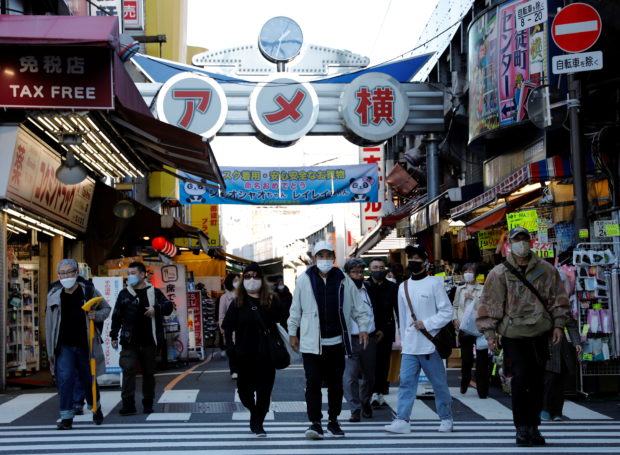
Pedestrians wearing protective masks, amid the coronavirus disease (COVID-19) outbreak, make their way at the Ameyoko shopping district in Tokyo, Japan, December 1, 2021. REUTERS FILE PHOTO
TOKYO — Record-high COVID deaths in Japan have been logged on several days amid the sixth wave of the pandemic, with the cumulative toll exceeding 20,000 as of Friday.
Even though the dominant Omicron variant is said to be less lethal than earlier forms of the virus, the number of coronavirus cases has been higher than in previous waves of the pandemic.
About 70% of COVID-19 patients who have died in the sixth wave were aged 80 or older, and many of them died of chronic health problems such as kidney and respiratory diseases.
In Japan, the first death from COVID-19 was confirmed on Feb. 13, 2020. The death toll had reached 10,000 in April 2021, about 14 months later. It has taken only nine months for the tally to increase by another 10,000.
On Tuesday, Japan logged 159 COVID-related deaths, breaking the previous record of 148 marked in May last year.
Record-high tallies were reported on the following two days and on Friday, 150 deaths were logged, raising the cumulative tally to 20,092.
However, the fatality rate has decreased during the sixth wave.
According to the Osaka prefectural government, the fatality rate of COVID-19 infected patients in the prefecture was 2.8% during the fourth wave from March to June in 2021 when the alpha variant was dominant, and 0.4% in the fifth wave triggered by the delta variant from June to December.
In the period from Dec. 17 to Feb. 5, the fatality rate was 0.07%.
According to the Health, Labor and Welfare Ministry, the nature of the Omicron variant and the use of vaccines and drugs are contributing factors to the low fatality rate.
New coronavirus cases exceeded 20,000 per day nationwide at the peak of the fifth wave: the daily tally has surpassed 100,000 in the ongoing sixth wave.
Even though the fatality rate is decreasing, the death toll is increasing because of the higher number of infections.
According to the ministry, 48% of people who died with COVID-19 were aged 80 or older during the fifth wave, when the deceased covered a relatively wider age group: 24% were in their 70s, 13% were in their 60s, and 10% were in their 50s.
In the sixth wave, elderly people have accounted for a higher proportion of COVID-19 deaths, with 71% aged 80 and over, 20% in their 70s and 9% aged under 70.
The decrease in the number of deaths among COVID-19 patients in their 60s and younger has been attributed to the decrease in the number of people with severe COVID-19 due to worsening pneumonia.
According to nonprofit organization Japan ECMO Net, about 1,000 people needed ventilators or extracorporeal membrane oxygenation machines at the peak of the fifth wave when pneumonia caused by COVID-19 was observed in all age groups.
However, the Omicron variant is more likely to spread in the throat than in the lungs. Only 279 patients have needed treatment with ventilators or extracorporeal membrane oxygenation machines as of Thursday.
There have been an increasing number of cases in which elderly people have suffered from worsening underlying diseases such as kidney, heart and respiratory diseases.
“Some patients lose strength from coronavirus infection and die of heart failure or old age,” said Norio Omagari, director of the Disease Control and Prevention Center at the National Center for Global Health and Medicine.
According to Omagari, many patients develop complications not from the virus but from bacteria entering the lungs. As seasonal influenza is known to cause bacterial pneumonia, COVID-19 patients have been treated with antibiotics.
“Considering that many elderly patients have died due to the deterioration of underlying diseases, it is necessary to treat patients early and ensure health monitoring to be offered people recuperating at home,” he said.
RELATED STORIES
Japan has zero daily COVID-19 deaths for first time in 15 months — media
Japan PM Kishida mulls easing COVID-19 border controls
Japan prepares beds, booster shots in COVID-19 lull before winter
Japan brings back virus restrictions over Omicron surge